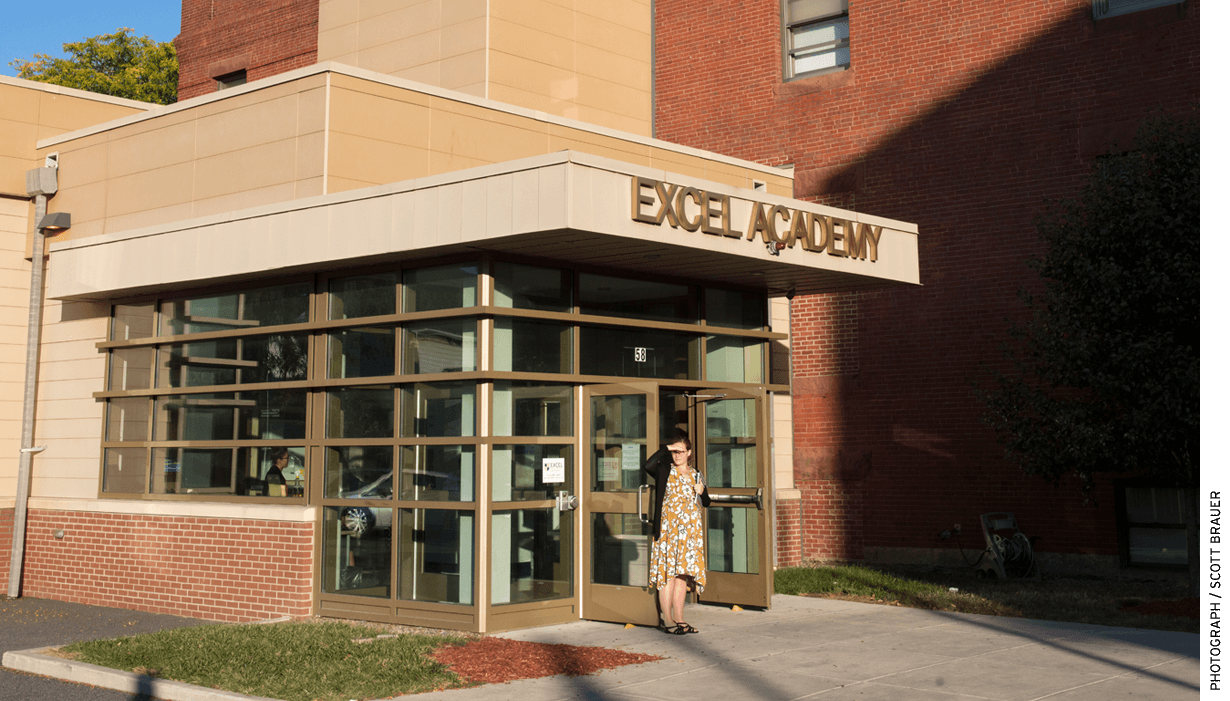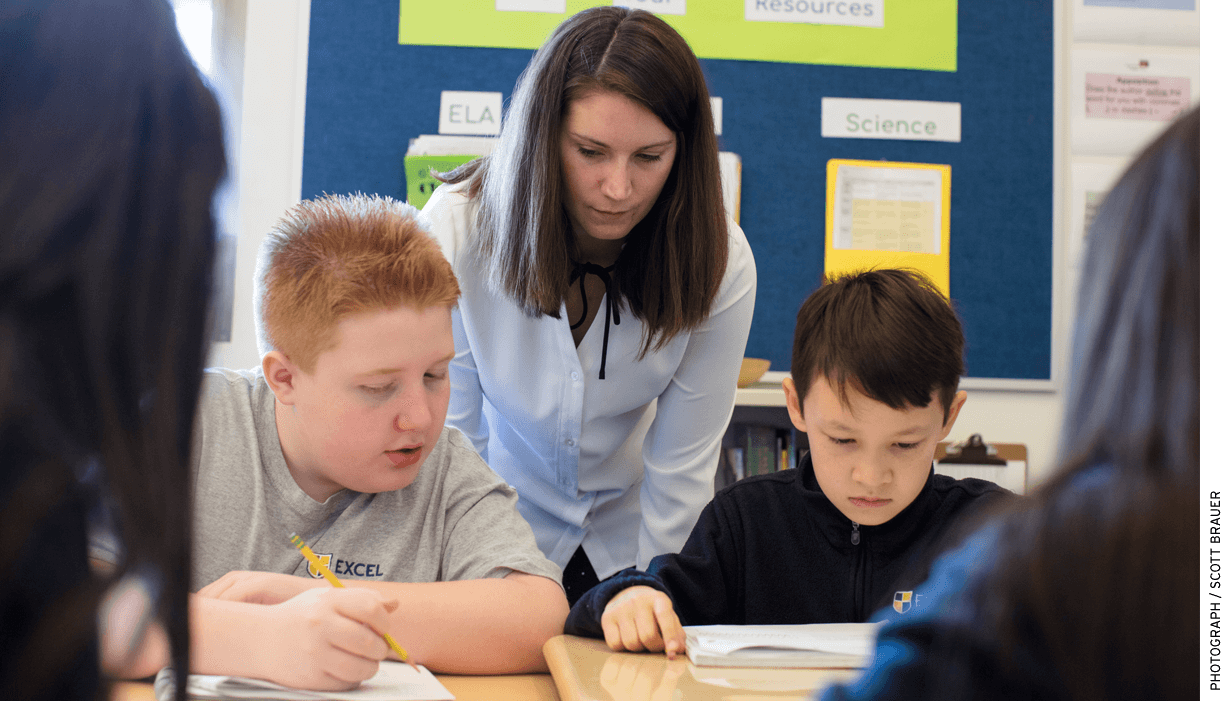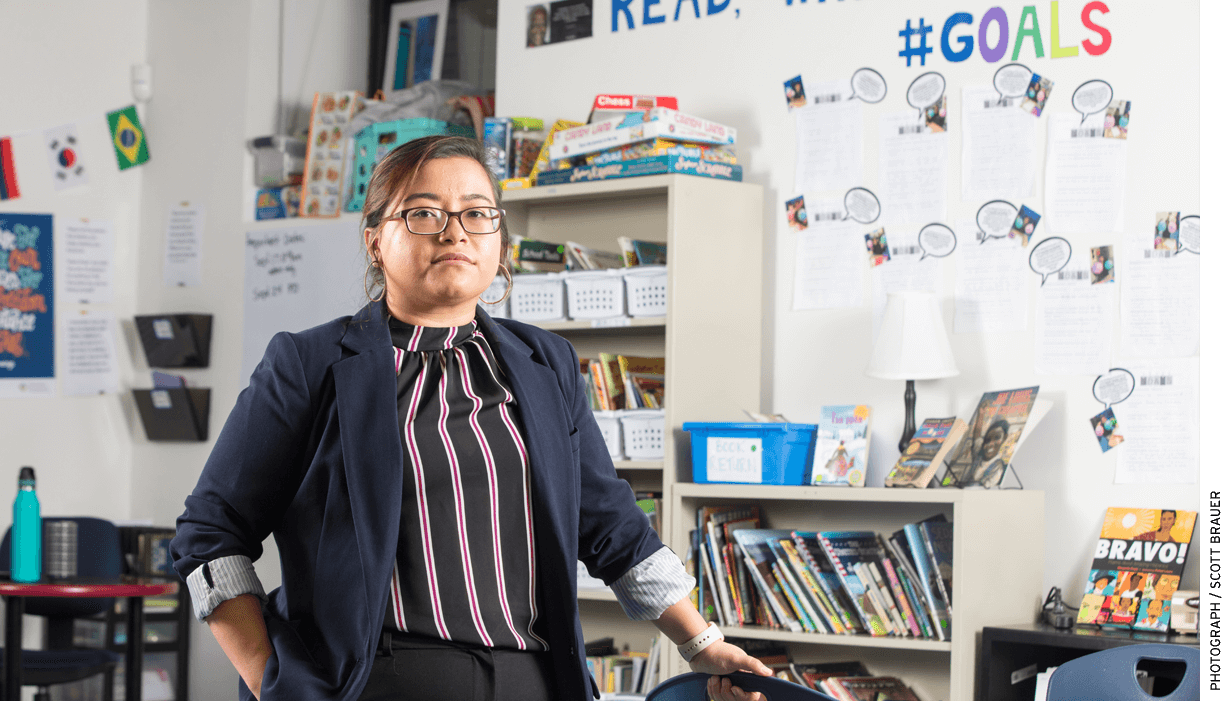
Carolina’s daughter was in 1st grade when her teachers made an upsetting discovery: she could neither read nor write.
The little girl had spent much of her kindergarten year in and out of the hospital, ill with what doctors finally diagnosed as a neurological disorder. She was promoted to the 1st grade, but after missing 35 days of kindergarten, she was hopelessly behind. Her teachers gave her mother two choices: the 6-year-old could repeat a grade, or a parent could accompany her to school to help her along.
Though she lacked any formal training to do so, Carolina agreed to join her daughter each day at the George F. Kelly Elementary School in Chelsea, a working-class city north of Boston.
“I stopped working,” said Carolina, a mother of five who was born in Guatemala, whose surname is being withheld to protect her daughter’s privacy. For three months, Carolina attended school from 8 to 11 a.m. “I learned how to teach her.”
For the next few years, Carolina’s daughter remained at the neighborhood school, where she was eventually diagnosed with several learning disabilities and qualified for tutoring and extra support. But as she approached middle school, doctors urged Carolina to consider sending her daughter to a specialized school for students with disabilities. There, the girl would be one of two or three students per class.
Instead, Carolina enrolled her daughter at nearby Excel Academy East Boston, a charter middle school that takes an inclusive approach to teaching special-education students.
“I wanted her to associate with other children,” she said.
There’s considerable public debate about charter schools and students with specialized needs, focused mainly on the extent to which charters enroll students who are classified to receive special-education services. A new study by Elizabeth Setren of Tufts University shows that critics, who often charge that charters do not serve as many special-education students as traditional public schools do, may not be asking the right questions (for more, see “A Charter Boost for Special-Ed Students and English Learners”). A school’s overall environment, not just access to specialized services, appears to be an important component to all students’ success.
Looking across the city of Boston, Setren compared the classifications and academic performance of charter-school students who were considered special-education students or English language learners at the time of their application with their peers in traditional public schools. Boston charters achieve better outcomes for those students than traditional public schools do, even though charter enrollment at least doubles the likelihood that students lose their classification and, as a result, access to specialized services. The types of educational approaches charters use—like data-driven instruction, more instructional time, and intensive tutoring—appear to benefit students with specialized needs just as they benefit their non-classified peers.
Presuming competence for special-ed students
Just after 7 a.m. on a cool morning in September, students clad in uniforms of khaki and navy blue began arriving at Excel Academy East Boston, forming an orderly line outside the building’s glass solarium. As the students in grades 5‒8 waited for the doors to open at 7:30, a fleet of yellow school buses arrived, carrying more of their classmates. The sound of airplanes taking off and landing could be heard from nearby Logan International Airport.
East Boston, known locally as Eastie, is a predominantly low-income immigrant neighborhood that sits between the airport and Boston Harbor. Some 53 percent of residents are Latino, according to Census Bureau data, and only about 69 percent of residents over the age of 25 have a high school diploma. It is also a rapidly gentrifying neighborhood, and a magnet for real-estate developers drawn to water views.
The school, which opened in 2013, has 241 students—a fraction of the 1,374 enrolled across Excel Academy Charter School’s network of four schools, whose mission is to prepare students for success in high school and college. Excel Academy schools are focused on high academic expectations, rigorous instruction, comprehensive family and student support, and consistent classroom and school rules. Across the network, 79 percent of students are Latino and 19 percent are classified to receive special-education services. Many are from low-income families where English is not the primary language spoken at home, and the vast majority meet or exceed standards on statewide reading and math tests. In 2014, for example, 100 percent of the network’s 8th-grade students scored “proficient” or “advanced” on that year’s statewide test in reading.
Most of the network’s special-education students learn in general-education classrooms. In the 2017‒18 school year, 80 percent of special-education students were in “full inclusion” programs, spending most of their day alongside general-education students, compared to the state average of 64 percent. Nearly 5 percent of Excel’s special-education students were in “partial inclusion” programs compared to the state average of 15 percent; those students spend some of the school day in general-education classrooms and other parts in separate classes. The network also runs a substantially separate special-education program called ROSE, which serves 13 students.
Administrators say Excel operates under the assumption that most students can learn effectively in general classrooms, and that the structure it has in place—its small scale, robust teacher coaching, and clear and universal standards and expectations—contributes to students needing fewer separate supports. Relatively low student-to-teacher ratios mean students get more individual attention, for example.
And so while many students, like Carolina’s daughter, now in the 7th grade, maintain their special-education status, others do not.
“It’s not that a student comes to us and immediately loses a classification. It’s a longer arc,” said Sarah Kantrowitz, the network’s director of student supports.
“It’s not like your disability ever goes away,” she said. “It’s really about: Do you still qualify for special ed? Do you need specially designed instruction and accommodation or do you not?”
At the very least, Kantrowitz said she wants to get to know the child for herself. “My mindset around special education is to always presume competency and always operate with the least dangerous assumption, which is that we want to keep options open for kids,” she said.
Carolina, for instance, knows her daughter’s disorder means she will continue to face academic challenges. But she has opted to keep her in a general-education setting with supports because she believes that not doing so would damage her daughter’s self-esteem. “It is for her well-being,” she said.

Making connections for English learners
Charters have their critics, including in Massachusetts, where a 2015 effort to lift a cap on charter enrollment was defeated by voters. But Setren’s research suggests that Boston charter schools are fighting above their weight class.
She found that public charter schools in the city spent 44 percent less on special-education services than traditional public schools did, but achieved higher outcomes due to “a set of education practices that affect all students, including increased instructional time, high academic and behavioral expectations, high-intensity tutoring, data-driven instruction, and frequent teacher feedback.”
The study also looked at English language learners and found that one year of attendance at a charter school substantially helps them catch up to their typical peers: It narrowed a gap in academic achievement by 84 percent in math and 39 percent in reading, for example.
English learners are entitled to specialized instruction of up to 150 minutes daily, based on their performance on a language skills exam. To accommodate those requirements in an inclusive setting, Excel has a two-pronged approach that includes structural modifications (think: small-group learning) as well as curriculum changes (that is, alternative assignments). Modifications could involve parallel teaching by a learning specialist, strategic pairing of students, or previewing lessons to students. Curriculum adjustments include providing additional reference materials, modifying or offering alternative homework assignments, or providing students with extra time or tools to complete their work.
Both approaches are woven into the fabric of the school, where learning specialists’ offices are strategically located in the center of each hallway. “It’s physically in the middle,” said Samantha Butera, a 6th-grade learning specialist at Excel East Boston. Sometimes she co-teaches with general content teachers. Other times, she said, “I pull a few students into my ‘learning lab’ for the same lesson.”
Butera and others, though, know they can’t cut too much into class time or ask students to come early or stay late. Instead, Excel has a “drop everything and read” block each day when students can get extra literacy instruction or tutoring. Such structures are helpful to both English learners and special-education students.
Samantha Doig, who teaches 5th- and 6th-grade science, said that in consultation with learning specialists, she may preview a lesson for students who are either language learners or receive special-education services. Those students may also get reference sheets and diagrams to help them access the material. But exams are uniform for all students. “All students can and should be able to answer the question,” she said. “They may just need an extra tool to get there.”
At the school, a lower-level hallway is festooned with flags from nearly every country. An English as a Second Language classroom features posters of Supreme Court Justice Sonia Sotomayor and civil rights activist César Chávez.
“People without experience working with English language learners think you just need to translate it into their language,” said Rachel Spencer, an English learner specialist and middle school department head.
Excel’s approach is more nuanced.
At the behest of one of its language specialists, the network replaced the term “English-language learner” with “emerging bilingual.” It also revamped progress reports to emphasize student growth.
By mid-September, Excel’s emerging-bilingual students had finished writing letters to their teachers to introduce themselves and articulate specific language goals. “One risk I am willing to take to achieve my goals is to raise my hand more,” read one.
Later that fall, sixth-grade students were reading Esperanza Rising, Pam Muñoz Ryan’s book about a 13-year-old girl who flees from Mexico to California and becomes a farm worker during the Great Depression. To facilitate their understanding, students read the story from a copy of the book that featured additional illustrations and reference notes.
Their teacher Lucero Castillo, a 6th grade English language specialist, said she spends a lot of her time reminding students that they are entitled to access a dictionary or reference materials. “You’re growing into your bilingualism,” she tells them. “Use your Spanish as a skill.”
She also encourages emerging bilingual students to draw on their heritage, not gloss over it.
“It’s about making those connections to help them access the materials,” she said.

Measuring progress for all
For Carolina and her daughter—now in her third year at Excel—the road hasn’t been easy.
Carolina struggles with English. Her daughter lives in fear of getting sick and falling behind again. Her neurological condition impacts her memory and makes reading and writing a challenge.
But the teen no longer feels like an outsider. And although her academic growth has been gradual, Carolina’s daughter is now able to complete homework assignments without help. That allows her mother to hold two part-time jobs, at Subway and at a local T-shirt shop. “I don’t have to be on top of her,” she said.
For many students with special needs, progress can be hard to measure. “Everybody’s measure of success may look different, so it’s hard to say, ‘Yes, they nailed it,’” said Kantrowitz, who said quantifying the success of an inclusion classroom is “messy” for that reason. “Trying to set a consistent benchmark is really hard.”
Doig, the science teacher, has imposed a daily test for herself. At the end of each class, she distributes “exit tickets” that post a broad question pertaining to her main learning objective for the day. In sharing their responses, students are acutely aware of their progress—and so is she. If 15 students in the class don’t answer the question correctly, she said, “is that on them or is that on me?”
Doig said she has the same expectations for all of her students; some just need additional scaffolding to get there. “Do they need a sentence starter? A diagram?” she asked. “All students can and should be able to make progress. All students can learn.”
In mid-September, Doig broke her class into groups, strategically mixing students with different learning styles and aptitudes. The groups then competed to answer a series of fill-in-the-blank questions to prepare them for their first science assessment the next day. “I’m setting them up to succeed,” she said. “If you don’t think all students can achieve, your students won’t achieve.”
E. B. Solomont is a Boston-based writer.
This article appeared in the Spring 2020 issue of Education Next. Suggested citation format:
Solomont, E.B. (2020). Inclusion in Action: Expectations for all at Excel Academy. Education Next, 20(2), 60-63.


